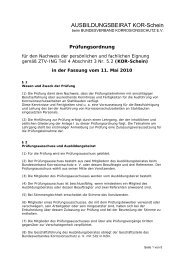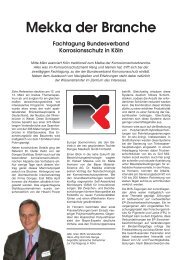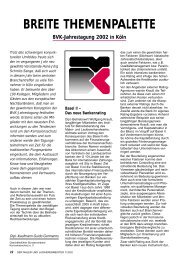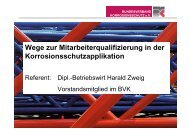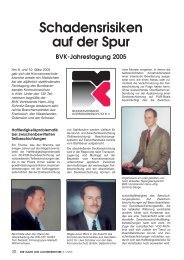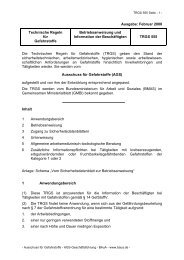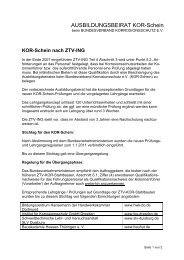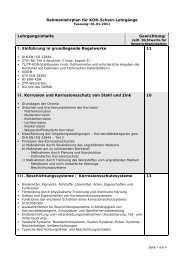Guideline of trade associations - VdL Verband der Lackindustrie e.V.
Guideline of trade associations - VdL Verband der Lackindustrie e.V.
Guideline of trade associations - VdL Verband der Lackindustrie e.V.
Create successful ePaper yourself
Turn your PDF publications into a flip-book with our unique Google optimized e-Paper software.
17<br />
� Ammonia solution wash with wetting agent (ANW):<br />
This method is using an aqueous solution <strong>of</strong> ammonia (NH4OH). A mixture <strong>of</strong> about 1 ¼ litre<br />
<strong>of</strong> ammonia solution, 10 % by mass, and 10 litres <strong>of</strong> water, with addition <strong>of</strong> 1 to 2 “crown<br />
corks” <strong>of</strong> wetting agent has been proved suitable.<br />
The surface to be cleaned is to be grinded with corundum inbedded plastics fleece and the<br />
above mixture until a grey foam is formed which should be allowed to react for about 10<br />
minutes. Afterwards it is to be thoroughly rinsed with fresh water.<br />
Caution: Legislation regarding waste water is to be consi<strong>der</strong>ed.<br />
For protection <strong>of</strong> the skin rubber gloves during the grinding work are appropriate; in the case<br />
<strong>of</strong> interior work good ventilation is to be provided. In no case steel wool shall be used for<br />
grinding.<br />
� Chromating:<br />
Chromating will normally be used in connection with the application <strong>of</strong> pow<strong>der</strong> coating<br />
materials. This method, to be carried out in shops or stationary plants only, comprises at<br />
least the following process steps: Degreasing – Rinsing – Pickling - Rinsing – Chromating –<br />
Rinsing – Rinsing with deionised water – Drying.<br />
� Phosphating:<br />
Analogously to chromating also phosphating <strong>of</strong> hot-dip galvanized surfaces is possible, in<br />
particular before application <strong>of</strong> pow<strong>der</strong> coating materials. The process steps to be carried out<br />
are similar, the measures with regard to protection at work are significantly less. Phosphating<br />
is preferably to be carried out using zinc phosphating solutions.<br />
Chromated and phosphated surfaces are to be provided with paint coatings immediately after<br />
the pretreatment. Also in the case <strong>of</strong> preparation by sweep blast-cleaning a short time period<br />
between preparation and application <strong>of</strong> the coating material is advantageous.<br />
Valid legislation regarding health, safety, and protection <strong>of</strong> the environment must be<br />
consi<strong>der</strong>ed for all methods.<br />
8 Test methods for paint coatings<br />
8.1 General<br />
Impairment <strong>of</strong> adhesion <strong>of</strong> paint coatings <strong>of</strong> duplex systems may normally occur after stress<br />
by humidity, e. g. during natural weathering, by condensation etc.. Testing the adhesion <strong>of</strong><br />
paint coatings exclusively in dry or unstressed condition is therefore meaningful at most in<br />
the case <strong>of</strong> interior applications without condensation conditions.<br />
On site a paint coating on a hot-dip galvanized surface (zinc-coated article) can be tested as<br />
follows:<br />
� Film thickness in accordance with EN ISO 2808 in connection with EN ISO 2360<br />
� Adhesion in accordance with EN ISO 2409 and EN 24624



